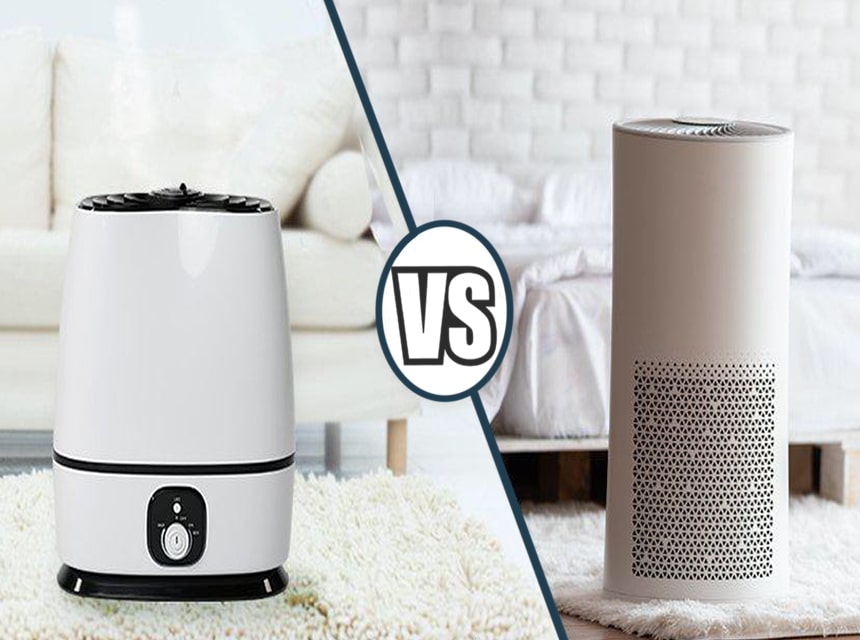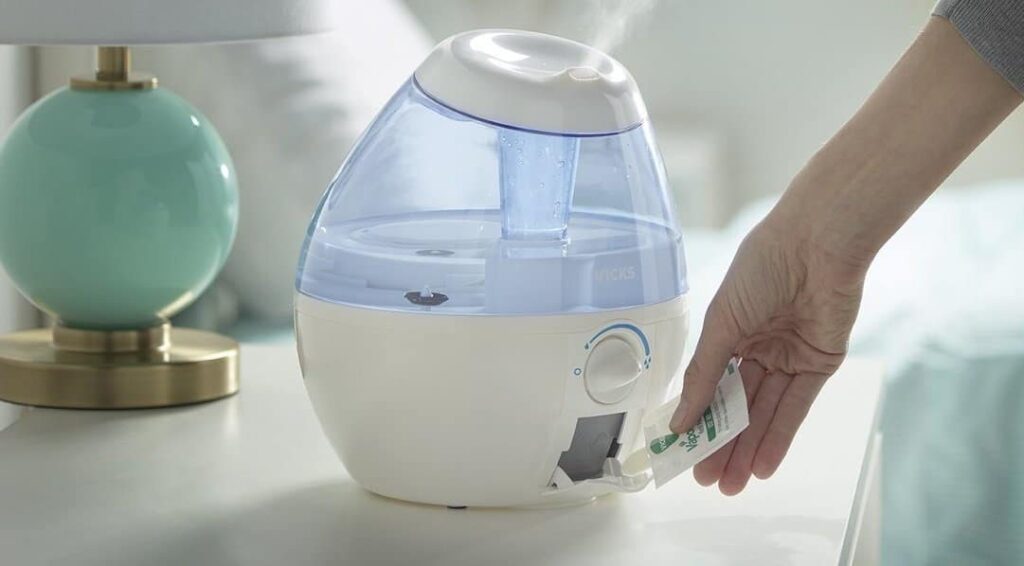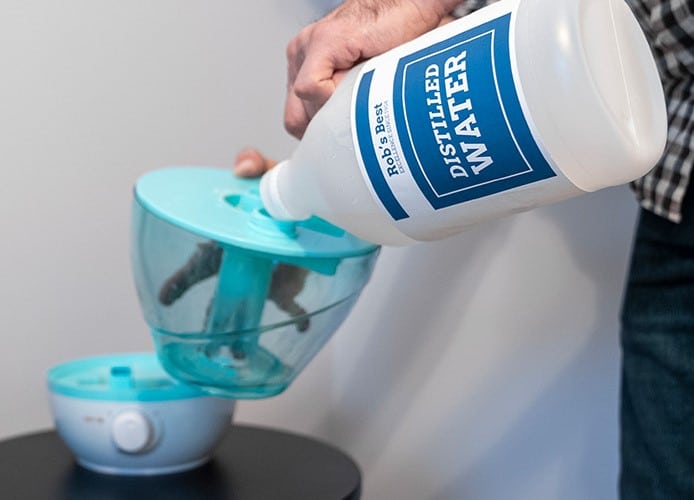If the indoor air in your home or apartment is dry, you can add humidity to the rooms using an air humidifier. Cool mist humidifying devices can make the air indoors more comfortable to breathe in the summertime. It can provide you some relief from problems such as sore throat, dry skin, and dry sinuses.
There are typically two types of cool mist humidifiers. These are the ultrasonic and evaporative humidifiers. Although both models are effective in humidifying the air in a room, these models are ideal for cough and sinuses, among other different advantages and disadvantages.
To help you choose the best humidifying unit, in this evaporative vs ultrasonic humidifier comparison article, we will highlight the difference between ultrasonic and evaporative humidifiers and the advantages and disadvantages of these two types of humidifiers. We will also tell you which one will be better and which is not advisable to choose in certain circumstances. Finally, we’ll make a side-by-side comparison of the two types of humidifiers. Continue reading!
This humidifier evaporates water in the air as much as possible, without spraying as the ultrasonic models do.
The evaporative humidifier works on the same principle of using pot jar with water or placing water bowls in a dehumidified room. However, it is the more efficient humidification method thanks to the wick filter and fan. The filter sucks in water, which is then blown into the room through the fan in the form of moist air. This principle is very simple and effective. Such humidifiers work with high efficiency and at the same time distribute the humid air throughout the room.
The evaporative humidifier is recommended for people with allergies and/or respiratory conditions like asthma. This is because they have filters that keep dist and other particles out. Also, due to their efficiency, these humidifiers are suitable for large rooms.
The operation of ultrasonic humidifiers is quite simple and yet extremely efficient. The device has three essential elements. First, a water tank that will allow it to increase the humidity of the air in the room where it is placed. Then, an ultrasonic plate will vaporize the water. Finally, a fan will send humidity into the room. There is also a float that cuts the device when there is no more water.
Inside the ultrasonic humidifier, water from the tank will be brought to the ultrasonic plate. When the device is turned on, this plate vibrates and emits ultrasonic that will break the water into an extremely fine mist. The fan will then send this mist to the outside to increase the humidity level.
Of course, the effectiveness of a humidifier like this depends on the model you choose. They all work the same, but the size of the tank, plate, and fan should be suitable for the size of the room you want to humidify. For very large rooms or offices, there are even models of industrial ultrasonic humidifiers that offer very high performance.
Ultrasonic humidifiers are very effective. However, it is not their efficiency that is the main argument for their success. Most consumers often turn to ultrasonic humidifiers than evaporative humidifiers. Yet it is not the efficiency of the model that convinces them in the first place.
First, many manufacturers have noticed that ultrasonic humidifiers have the advantage of making visible the mist sent into the room. This is just a detail that does not change the effectiveness of the product, but it seems that it reassures customers. Models without ultrasonic humidify without the process being visible. They, therefore, give the impression that they’re not working.
It emits no heat and it is perfectly silent. The built-in fan makes almost no noise, and the ultrasonic cannot be heard by the human ear.
Ultrasonic humidifiers do not emit any heat source. It is therefore not dangerous for children and can be used during periods of high heat without the risk of increasing the temperature of the room. According to tens of thousands of users who have tried it on Amazon, the TaoTronics 4L Humidifier is one of the best cool mist ultrasonic humidifiers. It is ideal for a bedroom, a large room, or a baby room.
Also, ultrasonic humidifiers are ideal for people with sinus problems.
In this section, we will compare the ultrasonic humidifiers and evaporative humidifiers using the same criteria:
This is a very important parameter that often influences the choice between ultrasonic and evaporative humidifiers.
The humidification performance of ultrasonic air humidifiers is in the order of a few hundred milliliters. So, they’re more like home humidifiers that you put on a table, next to flowers, and in general in places where you struggle with dry air.
If you want to humidify larger rooms or distribute the air over a larger area, you will need to place a fan next to the device to further distribute the water mist.
Much higher performance can be achieved with this device. Depending on the size and performance, the humidification performance of these devices is up to 1 liter per hour. However, such a humidification performance can only be achieved under extreme conditions (when the relative humidity is 20% and the room temperature is 40 ° C). Meanwhile, such conditions do not exist in an average household. So the devices can achieve values of around 400 ml per hour under normal conditions.
With such a high output, however, it is necessary to manage the moisture given off well. This is now been solved in a very elegant way in that most devices have a fan installed that blows the humidity into the environment and thus distributes the humid air throughout the room.
If you’re looking for a powerful humidifier, the one with evaporation is the right choice. For instance, a model such as the Vornado Evap40 4-Gallon Evaporative Humidifier can humidify a room capacity of up to 1,000 square feet. Its high speed is adjustable from 750 to 1600 rpm in three levels.
The appearance of the device is not that important to its operation, but we know from experience that many people also choose the device based on its appearance.
This type of humidifier is available in several designs and sizes, on which their performance often also depends. In general, the higher the performance of the device, the larger its water tank should be. And the tank is one of those things that significantly affects the size and often the design of the device itself.
We can find a wide range of ultrasonic humidifiers on the market, from classic models to devices of various shapes and colors. This type of humidifier is available in several designs and sizes, on which their performance often also depends. In general, the higher the performance of the device, the larger its water tank should be.
The general rule that says: “The higher the humidification capacity, the larger the water tank should be”, of course also applies to evaporative humidifiers. Since this type of humidifier often has higher humidification performance, they require a larger tank.
Also, the device must have a fan and a filter. On the other hand, there are also less powerful devices on the market that are small and can be placed on the desk, for example, to humidify the air at work. However, the range of these devices is not as large as, for example, that of air humidifiers with ultrasonic technology.
Appearance is a very subjective criterion. We know from experience that the ideal device should be small and powerful, among other things. However, if you do not want to constantly top up the water in the tank, accordingly, unfortunately, you have to compromise somewhere and choose the device regardless of its appearance.
Overall, however, we can say that ultrasonic humidifiers offer a wider range of devices with a more interesting design in this regard. This is why they emerge as winners in this comparison.
One of the very important parameters is the noise level.
The most common location for a portable humidifier is in the bedroom Trusted Source The Best Place for a Humidifier If you’ve decided that your home or bedroom is too dry, how do you pick a humidifier? Where’s the best place to put it? Find out here. www.thespruce.com . So it’s no wonder that most consumers want a humidifier that runs quietly. So, if the humidifier noise level is the main criterion for you, an ultrasonic humidifier is your best bet. The ultrasonic humidifier does not have a fan that would increase the noise level of the device.
If noise is not a problem but the budget is, choose a cheaper evaporative humidifier. However, you should know that even humidifiers (with natural evaporation) that have a quiet operation are a bit noisy due to the fan.
Among other things, this generates small vibrations and is easy to hear during operation. The solution is to set the fan to the lowest possible speed. Humidification then takes place more slowly, but more sensitive people will no longer be bothered by the noise of the device.
Although some evaporative humidifiers run optimally quietly, most ultrasonic humidifiers operate more quietly precisely because they do not have a fan, which keeps noise levels down.
Another very important indicator is the possibility of repair and maintenance of the device.
When using ultrasonic humidifiers, water scale plays an important role. Sooner or later, you just come across it and find that it’s difficult to remove from the device. Since there is no filter that at least partially removes these limescale deposits, the scale gets everywhere in the device, which leads to its clogging.
Also, ultrasonic humidifiers tend to give off more white/gray dust than evaporative humidifiers. The deposits return to the room together with the moisture and settle on furniture and electronics in the form of dust.
Tip: Use distilled water to control scale in the form of white dust in the humidifier. While this is more expensive, you can be sure that unwanted particles will not get into the air.
The humidifier with evaporation technology is particularly popular because of its filter. This also catches mineral deposits and thus reduces the risk of fine particles entering the room. Also, keep in mind that some compact evaporative humidifiers don’t have a built-in filter. As a result, they emit less moisture and the dust is barely noticeable, if at all.
The evaporative humidifier’s filter, which traps mineral deposits, makes a difference in the maintenance of these two types of humidifiers. In general, cleaning the tank and the device is easier with an evaporative humidifier.
| Evaporative humidifier | Ultrasonic humidifier | |
| Best applications | Cool-mist humidification
Humidity circulation with a fan Trap dust |
Cool air humidification
For reducing germs For a quiet environment |
| Efficiency | If you’re looking for a powerful humidifier against allergies and respiratory problems, the one with evaporation is the right choice. | Ultrasonic humidifiers are not as efficient as evaporative models. |
| Durability | Two to five years | Two to five years |
| Running cost | Evaporative models consume more energy | ultrasonic humidifiers are more cost-effective. |
| Price | Evaporative models are more expensive. Starts from around $100. | Ultrasonic models are less expensive. Start from around $50. |
It cannot be said in general which of the two types of humidifier is better. Technologies vary, and if you are looking for a powerful humidifier that will effectively humidify a room, an evaporative humidifier is the right choice. However, if replacing and cleaning the filter is not your thing, or if you are just looking for a quieter humidifier, choose a model with ultrasonic technology.
Again, as we have seen in the evaporative vs ultrasonic humidifier comparison article, your needs will determine which is the overall best.





